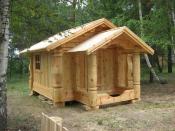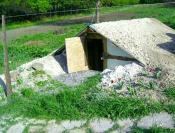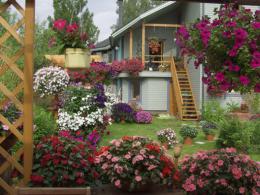Search
Login
Recommended
How to grow a petunia
Using your imagination, you can make unique compositions of flower beds from various flowers of petunias. The garden can become so bright and interesting, thanks to these extraordinary, but at the same time, simple plants.
Content:
- General information. A bit of history
- Petunia garden
- Why petunia
- Growing seedlings. Top dressing video
- Petunia Care video
General information. A bit of history
Petunia is a seasonal garden plant, first found and described in Uruguay in 1793. Lamarck carried it to the Tabakov family and gave the name Nicotiana axillaris. After 10 years, he was found in the American rainforests and was named Brazilian Petunia, which means tobacco.
Currently, there are more than 100 species of petunias. Their number is growing, thanks to breeders and people involved in the cultivation of these amazing plants in the garden or in the cities. Since there are a lot of species, a more convenient division into 4 main groups is accepted:
-
multi-flowered;
-
large-flowered;
-
floribunda;
-
ampelous.

The development of a petunia bud occurs within one week, and the flower itself blooms for about 5 days. Its seeds, retaining germination for 3 to 4 years, ripen about a month after pollination. Its fruit resembles a box with two wings. It is where the seeds ripen.
Petunia garden
In landscape design, Petunia Garden is used, which grows well where there is a lot of light and heat: in open sunny places.

This multi-flowered species is quite unpretentious, but there are still some growing conditions. It is important to remember the vulnerability of its flowers: they, being the most beautiful part of the plant, are the weakest. Although the plant itself is rain- and wind-resistant, as well as cold-resistant, the flower must be protected from rain, wind and frost. You can make shelter for them and water only under the root, without getting water on the flower itself. If the weather deteriorates, petunia ceases to bloom for a while.
Why petunia?
Firstly, petunias are unusually beautiful flowers: their bright color can fall in love with anyone. You can find pink, and purple, and white, and purple, and red-white flowers, and many others: for every taste. Some species even have two colors of flowers on one plant.

Petunia blooms for a long time: it can be said constantly (until the frost), which means that a garden decorated with petunias will bloom almost all year round. Not only the color of the petunia is diverse, but also the shape of the petals. They are smooth, and they are fringed and corrugated. Of course, terry is the most elegant, but the eyes can not be torn from any.

The second reason why it is good to grow petunias in the garden is the fact that the petunias are unpretentious. They do not need any particularly difficult care. Especially if you grow them in the garden, and not in containers, hanging baskets or pots. After all, they need drainage in them, it is important to take into account the ratio of soil and drainage with special additives. In the garden, this is not necessary.
Briefly characterize the positive qualities of petunias as follows:
-
flowering brightness;
-
unpretentiousness;
-
flowering time;
-
have drought tolerance;
-
adaptability to almost any climatic conditions, cultivation conditions and soils;
-
perfectly combined with other plants: there is no need to plant them separately;
-
well tolerate transplant;
-
have a certain popularity and a long history.

All these qualities have made her popular all over the world. It does not grow, perhaps, in Antarctica. For the climate of Russia, this flower is ideal if planted in the winter and left in a cool dark place.
Growing seedlings. Top dressing
It is necessary to sow petunia seeds depending on the type: ampelous in January with artificial lighting, terry in early February, and garden in the middle or end of February. If it is not possible to use the backlight, it is better to sow the seeds in March. Growing seedlings usually lasts about 80 days from sowing the seeds and until the plant sprouts, shoots, grows stronger and begins to bloom. You don’t need to sprinkle the earth with your hand after surface sowing, because the seeds are more often dragee-coated.

It is most convenient to sow them in mini-greenhouses, which can be made from ordinary transparent food containers with a hole in the bottom, into loose and permeable soil. Earth, in addition, must be moistened. And after unfolding the seeds, it is necessary to spray water on the ground. The greenhouse should be covered with a lid. After 4 to 5 days, seedlings can already be expected.
It is necessary to plant seedlings in the evening or on a cloudy day at a distance of about 20 cm from each other, immediately pouring water. Ideal landing time: April May. After planting, you need to water them once every two days, and every day you can spray them, it is advisable to do this in the evening.
This video will tell you some secrets of growing seedlings.
Seedlings need to introduce a complex of mineral fertilizers to increase the nitrogen content. This will result in lush flowering of petunias. When the plant becomes an adult in the summer, it should be fertilized with potassium monophosphate (about 15 g per 10 liters of water), as well as iron chelate to prevent yellowing of the leaves. It is also necessary to periodically add mineral fertilizers to the soil.
Petunia Care
It is very important to plant it in good soil, adding manure, compost or humus to it, so petunia will have an additional source of nutrients. Experienced gardeners, in order to avoid the appearance of parasites, advise not to use fresh manure. Fertile loam or sandy loam can serve as soil. As mentioned earlier, these are light and heat-loving plants, so plant them so that sunlight falls on them, but not in the open. Use a canopy or some other shelter.

When one flower fades, while the others are not around, this faded flower will spoil the whole look. Therefore, it will be advisable to cut it with scissors. You need to do this about every 3 to 4 days to maintain the decorativeness of the plant: namely, for the growth of new branches and, accordingly, the splendor of the bush.

Sometimes there is such a problem as aphids, fleas, snails and slugs, as well as root rot or gray mold. You can get rid of them with special chemicals, such as systemic insecticides (Confidor, Mospilan, Aktar) or biological preparations Trichodermin, Previkur, Aktofit, Fitosporin. The most important thing in this matter is prevention: watch for soil moisture, lighting, nutrition. And petunias do not have any specific diseases.

Create incredible flower beds in your garden, planting petunias, caring for them with love. And they will repay you with magnificent colors and bring beauty to your garden.





